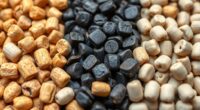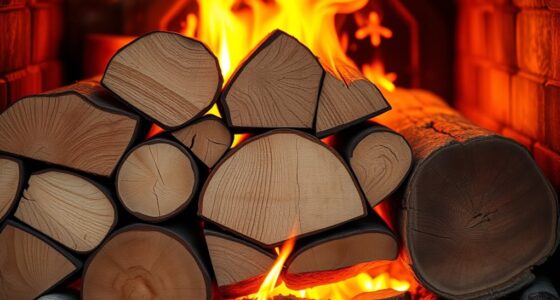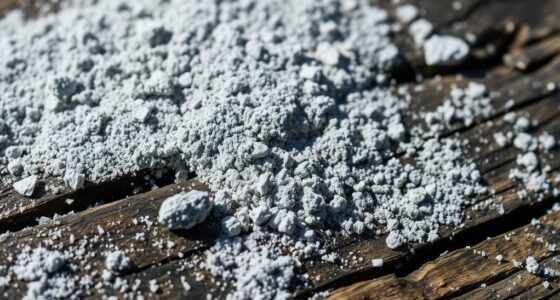You can switch your wood stove to eco-friendly fuels like compressed wood bricks, biomass pellets, or smokeless coals such as anthracite briquettes, which burn cleaner and more efficiently. Eco options like coffee logs, soy-based logs, and briquettes reduce emissions and support sustainability. Proper fuel selection, storage, and compatibility with your stove guarantee safe and effective heating. Keep exploring to discover more about choosing the best alternative fuels for your stove and how to use them safely.
Key Takeaways
- Eco-friendly options like compressed wood bricks, coffee logs, and wood pellets offer cleaner, longer-lasting combustion for wood stoves.
- Smokeless coals such as anthracite briquettes and ovoids provide high heat with minimal emissions and smoke.
- Biomass fuels like bio logs and briquettes reduce particulate matter and support sustainable heating practices.
- Ensure fuel compatibility with your stove by checking manufacturer guidelines for alternative fuel types.
- Proper storage and handling of alternative fuels improve safety, combustion efficiency, and reduce environmental impact.
Types of Solid Fuels Suitable for Wood Stoves

Not all solid fuels are compatible with every wood stove, so it’s important to choose the right type based on your stove’s design and manufacturer guidelines. For ideal combustion, select solid fuels that match your stove’s specifications. Traditional firewood is common, but eco-friendly alternatives like compressed wood bricks, coffee logs, and wood pellets burn cleaner and produce less smoke. Smokeless coals such as anthracite briquettes and ovoids generate high heat with minimal emissions, making them suitable for multi-fuel stoves with raised grates. Some fuels like peat briquettes and soy or switchgrass logs offer longer burn times and reduced smoke, fitting certain stove models. Properly selecting your solid fuel ensures efficient combustion, reduces harmful emissions, and helps prevent damage to your stove’s technology. Additionally, considering aesthetic wall organization solutions can help keep your stove area tidy and visually appealing. Understanding fuel characteristics can further optimize your stove’s performance and longevity. Being aware of combustion efficiency can also guide your fuel choices for better energy use and less pollution.
Benefits of Using Eco-Friendly Fuel Alternatives
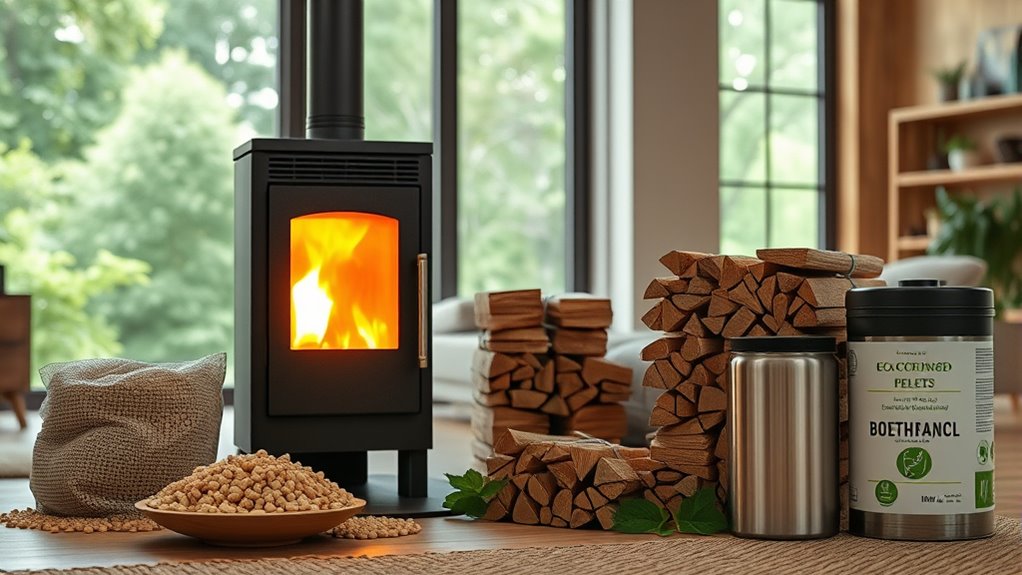
Using eco-friendly fuel alternatives offers significant environmental and practical benefits for your wood stove. These eco-friendly fuels, like bio logs and briquettes, produce fewer emissions and support waste recycling, reducing your environmental impact. Renewable biomass fuels, such as pellets and eco logs, help decrease reliance on traditional firewood and fossil fuels, promoting sustainability. Many eco-friendly fuels emit less particulate matter and toxins, improving both indoor and outdoor air quality. Bioethanol, for example, is considered carbon-neutral because it absorbs CO2 during plant growth, offsetting emissions during combustion. Choosing these alternatives results in cleaner burning, less creosote buildup, and longer-lasting heat, which enhances stove efficiency and reduces maintenance. Additionally, improved air quality benefits both your health and the environment. Some eco-friendly fuels are even designed to be easier to handle and store, making them more convenient for everyday use. For example, the use of renewable biomass fuels like pellets can significantly reduce the carbon footprint of your heating system. Overall, eco-friendly fuels are a practical choice for a greener, healthier home environment.
Common Types of Smokeless Coal and Their Characteristics
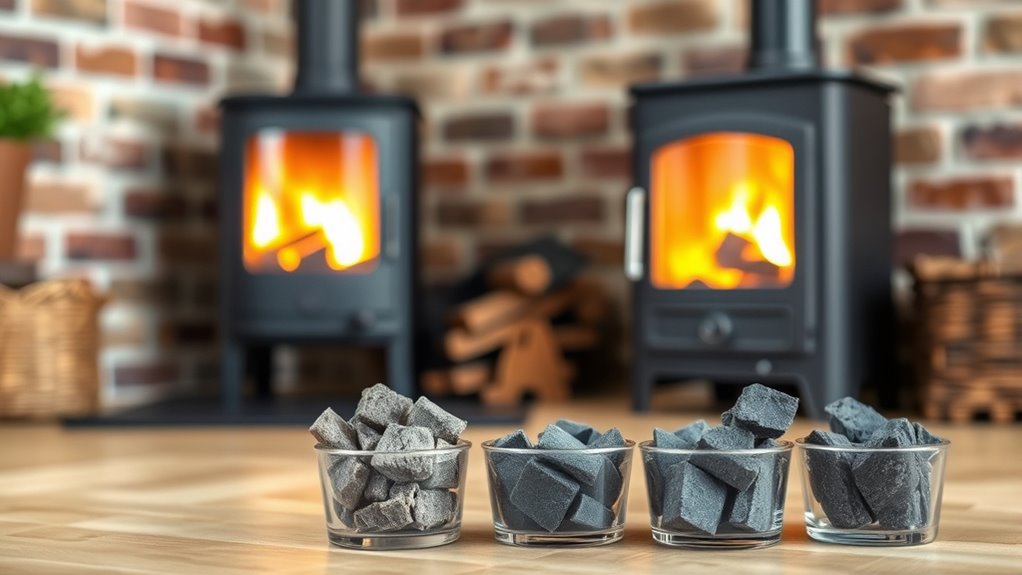
Smokeless coal types like Brazier, Briteflame, and Taybrite are known for their high calorific values, providing more heat per kilogram than traditional wood. They contain over 97% carbon, which helps minimize smoke emissions during burning, and their sulfur content is kept below 2% to guarantee they stay smokeless. These characteristics make them an efficient and cleaner alternative for your stove.
High Calorific Values
High calorific values are a key advantage of common smokeless coals, which are primarily anthracite-based. These fuels deliver high calorific values, often around 32.50 MJ/Kg, making them more efficient than dry firewood. Their low moisture content and high carbon percentage enable smokeless coals to produce intense heat and maximize energy efficiency. Many are available in briquette form or ovoid shapes, designed for easy handling and consistent combustion. These alternative fuels generate up to 24% more heat compared to traditional coal, with minimal smoke emissions due to their high carbon content and low sulfur levels. Their high calorific value guarantees you get more warmth and heat output from less fuel, making them a practical and effective choice for maintaining a warm home efficiently. Additionally, their drainage characteristics help prevent issues such as moisture absorption, ensuring a cleaner and more reliable burn. Properly stored smokeless coal also benefits from moisture resistance, which further enhances combustion efficiency and reduces the formation of creosote. The high energy density of these fuels means you need less volume to produce the same amount of heat, contributing to easier handling and storage. A well-designed storage system can help preserve the calorific value over time and improve overall combustion performance. Maintaining proper storage conditions also helps preserve the calorific value, ensuring the fuel remains efficient over time.
Smoke Emission Limits
Have you ever wondered how certain coals produce minimal smoke while still delivering strong heat? This is where smokeless coal shines, especially anthracite, which has over 97% carbon content, resulting in low smoke emissions during combustion. These fuels are carefully engineered, like Brazier, Briteflame, and Taybrite, to emit about 80% less smoke compared to traditional coal. Their limited sulfur content—2% or less—helps prevent harmful sulfur dioxide emissions, making them truly smokeless fuels. The high calorific value, around 32.50 MJ/Kg, ensures efficient burning with fewer particulates and toxic emissions. Proper storage and handling also play a role in maintaining the low smoke qualities of these fuels. By choosing these low smoke fuels, you reduce smoke emissions and enjoy cleaner, more efficient combustion, making them an excellent alternative for environmentally conscious wood stove use.
Eco-Friendly Biomass Options for Heating
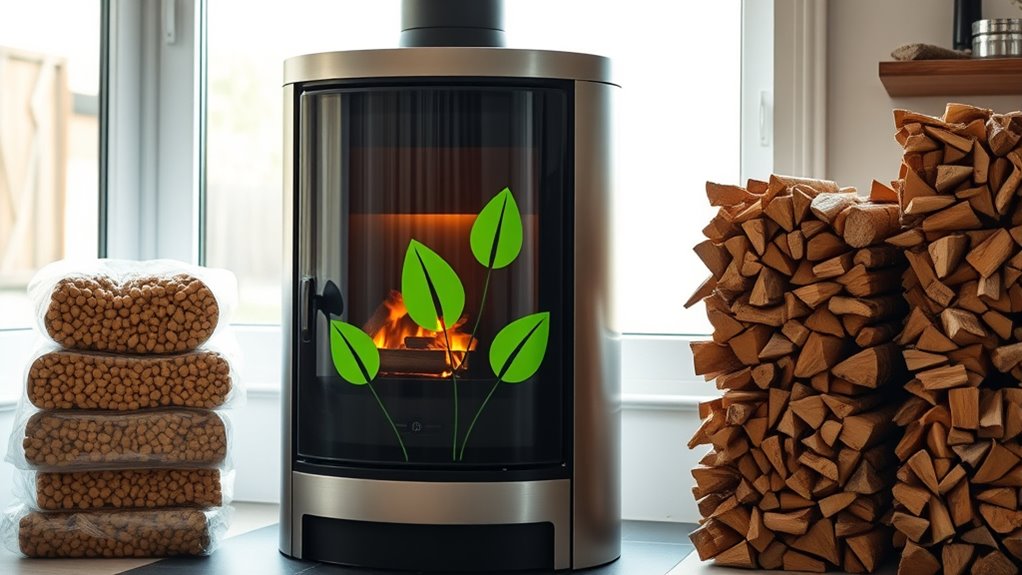
Eco-friendly biomass options for heating offer a sustainable alternative to traditional firewood, helping you reduce waste and lower your environmental impact. Biomass fuels, like wood pellets, coffee logs, and briquettes, are made from recycled or renewable plant materials, supporting recycling efforts and decreasing reliance on fossil fuels. Wood pellets are highly efficient, low-moisture fuels that burn with minimal smoke, but they require specialized pellet stoves. Coffee logs, produced from used coffee grounds, burn hotter than seasoned firewood and can cut greenhouse gases by over 130%. Biomass briquettes and eco logs are designed for cleaner, longer-lasting combustion, often emitting fewer particulates and greenhouse gases. Using these options supports sustainable heating and promotes renewable energy practices in your home. Additionally, the horsepower of electric dirt bikes demonstrates how alternative energy sources can power efficient, high-performance equipment. Exploring renewable energy solutions like these can further enhance your eco-friendly heating system. Incorporating proper sleep habits can also improve overall well-being, boosting energy levels and supporting your commitment to a greener lifestyle. Moreover, choosing biomass fuels with low moisture content ensures cleaner burns and better heat output, making them a practical choice for environmentally conscious homeowners.
The Role of Bioethanol as a Clean-Burning Alternative
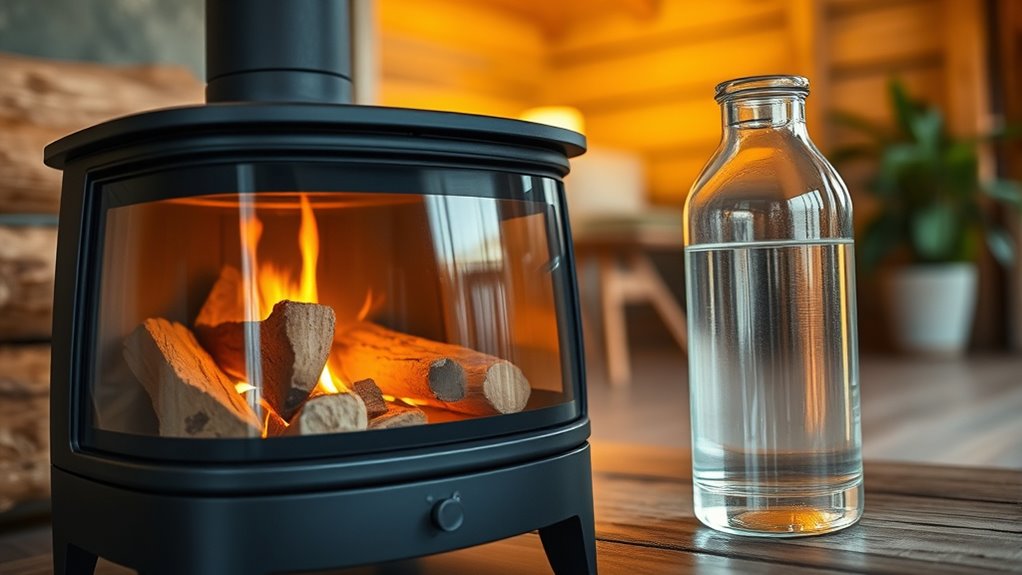
Bioethanol emerges as a promising clean-burning alternative for modern wood stoves, especially since it produces minimal soot and smoke. As a renewable, alcohol-based fuel, bioethanol is a sustainable fuel source derived from fermenting crop waste like sugarcane and grains. Its combustion emits mostly CO2 and water vapor, making it an eco-friendly choice that reduces air pollution. Unlike traditional solid fuels, bioethanol requires no chimney or venting, allowing safe indoor use in specially designed fireplaces or inserts. Its high energy density ensures controlled, consistent burns, providing a safe and environmentally friendly alternative to fossil fuels. Additionally, understanding Gold IRA Rollovers can help diversify your investment portfolio to support sustainable and eco-friendly initiatives. By choosing bioethanol, you promote cleaner combustion and a greener approach to home heating, reducing environmental impact and aligning efficiency with sustainability.
Making and Using Recycled Paper and Wax Logs
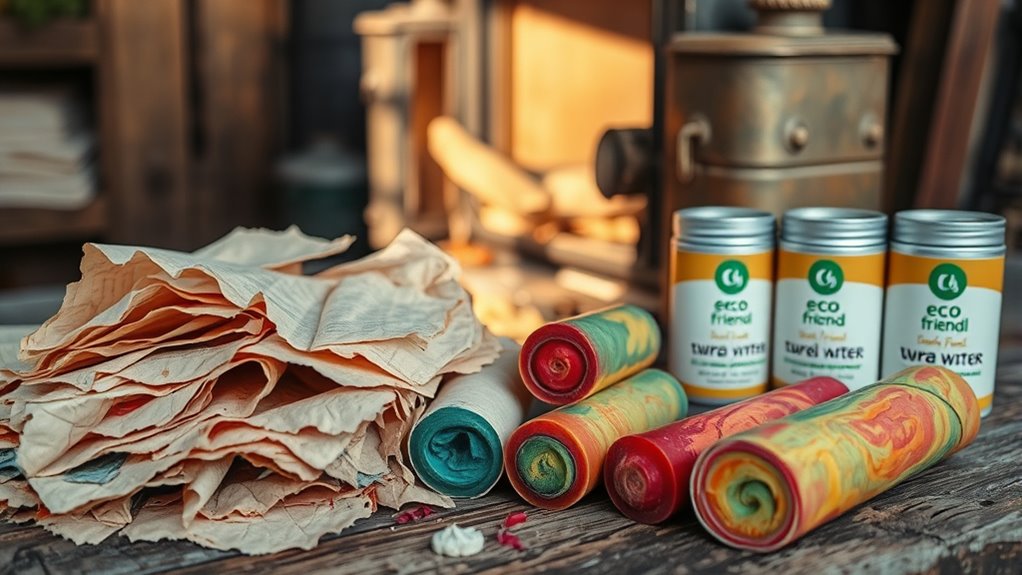
Recycling waste materials into functional fuel logs offers an effective way to reduce landfill waste while providing a reliable heat source. To make recycled paper logs, shred newspapers and junk mail, soak them in water, then compress and dry into briquettes for burning. Wax logs are produced by mixing petroleum wax with sawdust, creating an easy-to-ignite, high-energy eco-friendly fuel that burns cleanly with minimal ash. Both types of logs should be stored indoors and properly dried before use to ensure efficient combustion and reduce smoke. Using these waste products promotes sustainable heating and minimizes environmental impact. Keep in mind:
- Recycled paper logs are cost-effective and straightforward to make
- Wax logs burn longer and cleaner than traditional firewood
- Proper drying enhances burn performance
- Briquettes serve as a reliable alternative to wood
- These logs help reduce landfill waste while providing consistent heat
- The combustion efficiency of these logs can be optimized through proper storage and drying methods.
- Incorporating positive thinking techniques can improve your motivation and commitment to sustainable practices, making the process more enjoyable and rewarding.
Tips for Safe Storage and Handling of Alternative Fuels
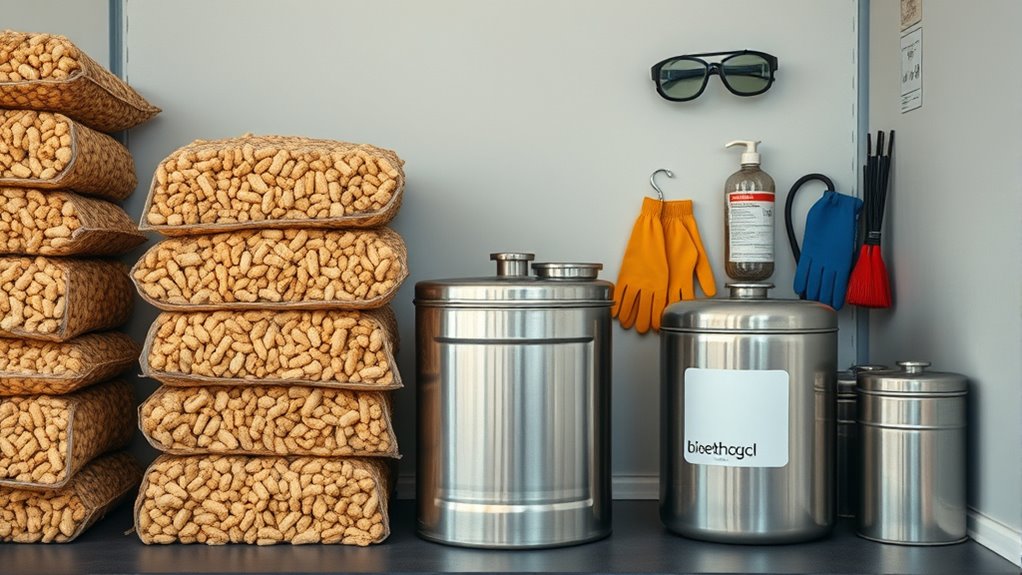
To guarantee safe storage and handling of alternative fuels like briquettes, eco logs, and pellets, you should keep them in a dry, well-ventilated area. Moisture can reduce combustion efficiency and cause clumping or mold. Use sturdy, labeled containers or pallets designed for specific fuels to ensure safety and easy handling. Protect fuels from water, rain, and direct sunlight to prevent spoilage or unintended ignition. Regularly check for signs of moisture, mold, or pests, and stack fuels properly to promote airflow and prevent spoilage. Ensuring proper filtration and maintenance of your heating equipment also helps maintain safety and efficiency. Developing a proactive mindset when managing fuel storage can help you identify potential hazards early and address them promptly. Additionally, proper ventilation in storage areas helps dissipate any fumes that may accumulate, reducing the risk of accidents. Properly organized storage also minimizes clutter and potential fire hazards, further enhancing safety measures.
Choosing the Right Fuel for Your Specific Stove Model
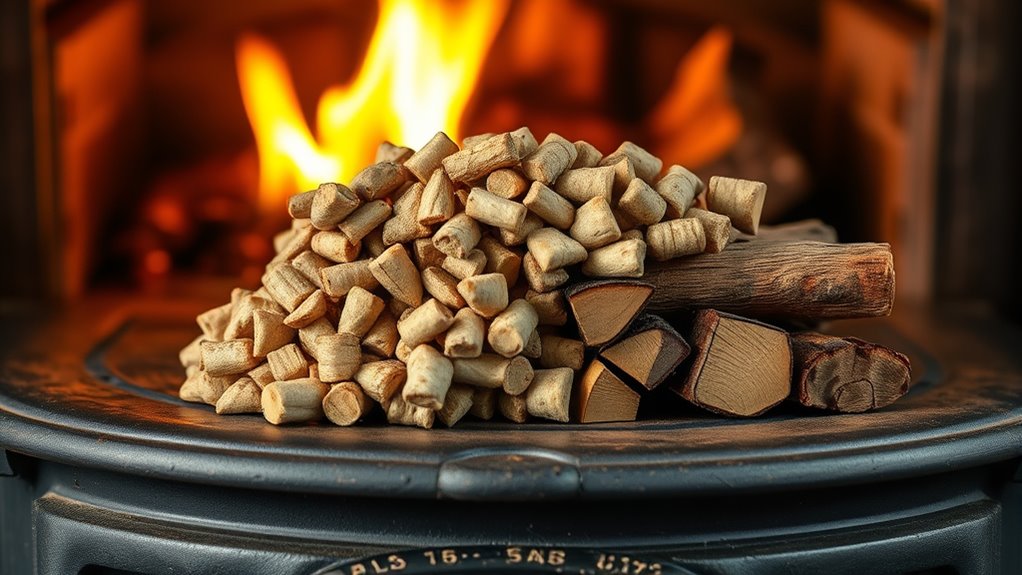
To choose the right fuel, you need to confirm your stove’s compatibility with various alternatives. Consider the fuel’s characteristics and benefits to guarantee safe, efficient burning. Always follow your manufacturer’s guidelines to prevent damage and meet emissions standards. Additionally, understanding the specific fuel types suitable for your stove model can help optimize performance and longevity.
Compatibility With Stove Type
Choosing the right fuel for your stove begins with ensuring compatibility with its specific design and intended use. Your stove’s type determines which fuels will burn very efficiently and safely. For example, multi-fuel stoves can handle smokeless coals, briquettes, and wood bricks, while dedicated wood stoves primarily burn firewood. Always check if your stove is DEFRA-approved or rated for eco-friendly alternatives like smokeless fuels. Use only fuels specified by the manufacturer to prevent damage or safety issues. Pay attention to the size and shape of your fuels—such as briquettes or ovoids—to fit your stove’s firebox and ensure proper airflow. Consider your stove’s heat capacity and burn rate to choose suitable fireside products, matching the fuel with your stove’s compatibility for ideal performance.
- Compatible fuels match your stove’s design
- Use manufacturer-approved fuel types
- Avoid incompatible materials like wax logs
- Select fuels that fit your firebox
- Match fuel density to your stove’s heat output
Fuel Characteristics and Benefits
Selecting the right fuel for your stove depends on understanding its specific model and how different fuel characteristics influence performance. The type of wood fuel you choose affects burning behavior, smoke production, and efficiency. For example, logs made from seasoned firewood burn steadily with minimal smoke, maximizing heat output. Eco-friendly options like coffee logs and wood briquettes burn cleaner and often produce higher heat—coffee logs burn about 20% hotter than seasoned logs. The form of the fuel—briquettes, pellets, or loose logs—also impacts ignition ease and burning efficiency, especially for small or large stoves. Choosing fuels suited to your stove’s design ensures ideal combustion, reduces emissions, and provides safe, effective heating. Proper selection helps you maximize performance and enjoy cleaner, more efficient heating.
Frequently Asked Questions
What Is the Alternative to Fuel in a Wood Stove?
When you ask about alternatives to fuel in a wood stove, you’re exploring eco-friendly options that burn cleaner and more efficiently. You can use biomass pellets, coffee logs, or compressed bio-bricks, which produce less smoke and emissions. Some modern stoves even handle recycled paper bricks or bioethanol, offering ventless, sustainable heating. Your choice depends on your stove’s compatibility, efficiency, and environmental goals, ensuring a greener, cleaner heating experience.
What Is the Least Polluting Fuel for a Wood-Burning Stove?
The least polluting fuel for your wood stove is bioethanol, which burns cleanly with near-zero particulate emissions and no indoor air pollution. It’s made from fermenting crop waste, making it an environmentally friendly choice. You can also opt for dry, seasoned firewood, eco logs, or low-moisture wood pellets, all of which burn efficiently and produce fewer pollutants. High-quality smokeless coals like anthracite briquettes are also cleaner options.
What Is the Cheapest Fuel for a Wood Burner?
When you’re looking for the cheapest fuel for your wood burner, recycled options like coffee logs or paper bricks stand out, costing just $5–$10 per brick or bag. You can also save money by buying dried, ready-to-burn firewood in bulk from local suppliers. While traditional hardwoods are affordable, recycling waste-based fuels offers the most budget-friendly solutions, letting you enjoy warmth without breaking the bank.
What Is the Best Alternative Fuel for Log Burners?
When choosing the best alternative fuel for your log burner, consider eco logs made from recycled wood fiber, which burn cleaner and produce less smoke. Coffee logs offer hotter burns while reducing greenhouse gases. Wood briquettes and compressed biomass blocks provide long-lasting, efficient heat with lower emissions. Smokeless coals like Taybrite or Calero deliver high energy output with minimal smoke, making them excellent choices for cleaner, efficient heating.
Conclusion
Switching to eco-friendly fuels, choosing safer storage, and understanding your stove all help you heat responsibly. By exploring alternative options, you reduce emissions, protect the environment, and enjoy cleaner, more efficient warmth. Making informed choices, embracing sustainable fuels, and prioritizing safety guarantee you create a cozy, eco-conscious home. With awareness, effort, and care, you turn your wood stove into a greener, cleaner source of comfort, benefiting both your household and the planet.


